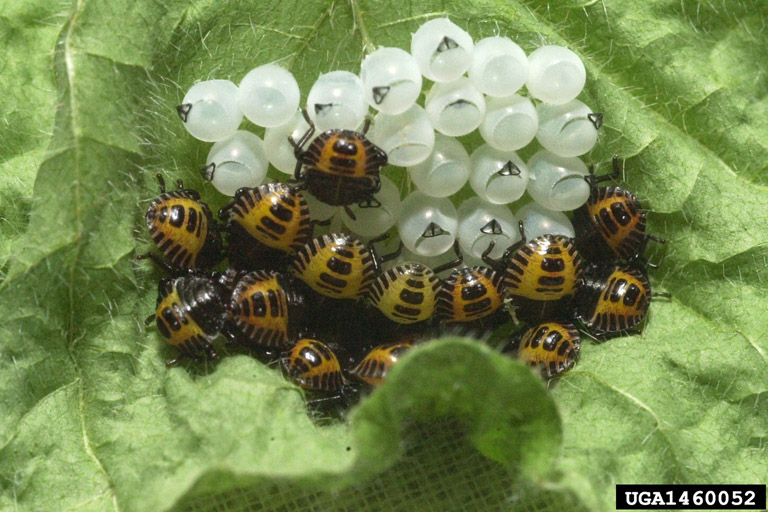Brown Marmorated Stink Bug

Brown Marmorated Stink Bug
(Halyomorpha halys)
Tags: Terrestrial
Identification and Reproduction
Identification:
Adult:
- Shield-shaped, 13 – 17 mm long, brown marbled appearance, alternating brown and white markings on the outer edge of the abdomen.
- Can be distinguished from other stink bugs by the presence of distinctive white bands on the last two antennal segments.
- Smooth and rounded shoulder tips.
- Has white bands on its legs.
- Release an unpleasant odor when crushed or threatened.
- Adults may be confused with other native brown stink bugs and western conifer seed bugs.
Eggs:
- Spherical, white or pale green, 1.6 x 1.3 mm; laid in clusters of 20 – 30 eggs on the underside of leaves.
Immature (nymph):
- Has a total of 5 immature stages.
- Nymphs range in size from 2.4 – 12 mm in length and do not have fully developed wings.
- 1st instar nymphs are bright orange to red in colour; 2nd instar nymphs are black, tick-like; later instars are pear-shaped, brown with white markings on abdomen and legs and white bands on last two antennal segments.
Reproduction:
- A single female can lay up to 400 eggs throughout the summer on host plants.
- Development from egg to adult takes approximately 40 to 60 days, depending on temperature and photoperiod.
Habitat & Ecology
- Ornamental hosts include tree of heaven, chokecherry, catalpa, boxelder, white ash, maple, English holly, and buckthorn.
- Stink bugs are great hitchhikers and have been observed in shipping containers, wood, wood packaging, cargo and vehicles.
- In British Columbia, they have been found on Asian pears, apples, hazelnuts, vegetables, wild chokecherries and many other host species.
- Currently, they present in high numbers throughout the Fraser Valley and the Lower Mainland
Impacts
- It feeds and attacks over 100 different plant species.
- Brown marmorated stink bug are a major agricultural pest, and will attack tree fruits, berries, grapes, vegetables and ornamental plants - affecting crops and food being grown on farms.
- They cause damage by feeding and creating puncture marks on produce. This creates small deadareas on fruit, vegetables and leaves.
- In the United States, BMSB causes millions of dollars' worth of crop damage and control costs annually.
- The presence of adult brown marmorated stink bugs can also taint wine production.
- They may also be a nuisance to homeowners as they overwinter in human-made structures.
Management
- Homeowners: Small numbers of brown marmorated stink bugs can be removed by hand, sweeping or a shop vacuum. Before disposal, dump bugs in soapy water to ensure they are killed. Prevent entry into the home by sealing off any access points. The use of insecticides for controlling brown marmorated stink bugs in the home is not recommended.
- If you find suspect BMSB outside of the Fraser Valley or the Lower Mainland, please report them to the BC Ministry of Agriculture.
Resources
For more information, refer to BC's Pest Alert on Brown Marmorated Stink Bug (BMSB) here.
For more advice on how to control BMSB in your home please refer to this guide.
For more help identifying this bug throughout its lifestages check out this BC Ministry of Agriculture resource here.
For more details on identificaion and management of BMSB check out the University of Florida's feature creature on BMSB here.
Download BC Ministry of Agriculture's BMSB factsheet here.
Header photo (Yerpo).




